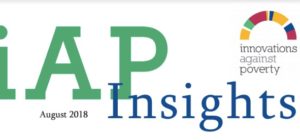Reports about precision agriculture are usually accompanied with images of gigantic tractors on endless fields. Reports about smallholders, on the other hand, usually show a thin man on a small plot of land ploughing with an oxen or reaping his meagre
harvest. The two images could not seem further apart. It is true: many smallholders work with limited resources, very few inputs and almost no machinery. Despite this, giving them access to precision agriculture is possible. And it could make a major contribution to reducing poverty and hunger.
Increasing yields - with data
Precision agriculture is a new farming management approach, where farmers capture and analyze data in order to optimize inputs and practices for best outcomes. Using sensors and remote images from satellites or drones, as well information from public sources and research institutions, farmers collect data on soil quality, weather, plant growth, hydration and so forth. This data then guides decisions on which crop to plant or when and where to apply fertilizer, agrichemicals or water. As a result, farmers can optimize the use of inputs, making maximum use of the little resources they have.
Overcoming barriers…
The barriers to making precision agriculture available to small farmers in low-income countries are significant, no doubt:
- Data availability: Although the availability of data on macro parameters like weather and soil is improving with satellites, drones and sensors, it still remains limited, especially in the smallholder context. Translating this data in actionable recommendations for small farmers requires the participation of government and grassroots organizations. In addition, broadband access remains a challenge in many rural areas. Internet connections can be slow, depending on the distance
to the next cell tower or speed limitations. - Access to inputs: Smallholders can only make use of the data if they can follow the recommendations with the right inputs. But availability of inputs is not a given.To illustrate: In Kenya, 35% of smallholder farmers have access to improved seed, in Tanzania only 15%. In the same countries, only 2-3% of smallholder farms are irrigated. The situation is similar in India; less than 2% of smallholder farms utilize irrigation techniques.
- Affordability: Precision agriculture requires expensive equipment. A drone costs at least US$1,000. An internet-enabled tractor costs around US$350,000. That is a lot for a farmer who may survive on less than US$2 per day. Many farmers don’t have access to credit to invest in higher productivity.
- Acceptance: Given their high exposure to risk and limited ability to manage shocks, smallholders often prefer to choose traditional methods and low-return production options over technology-intensive ones.
… requires multiple actors
Many organizations are already working to overcome these barriers:
- Producers of agricultural technology are developing smaller versions and new types of devices that meet the needs of small farmers. Equipment is becoming cheaper, with ever more affordable drones being built, and the cost of sensors
going down. Agricultural equipment is also becoming more affordable. One example is the AyaPump - providing smallholder farmers in rural Ghana an easy and affordable way to water their crops during the dry season, it costs under
$US50. - Social enterprises provide data services to smallholders and facilitate access to finance, machinery, inputs and markets. eKutir, Farmerline, Farm Africa and others deliver market information, advice on good agricultural practices, weather
forecasts and more. The sharing economy also reaches small farms. Mahindra, for example, provides hiring centres for farm equipment with its mobile app TRRINGO. - Network operators are investing in broadband, including in rural areas. Whilst internet access is projected to reach only 41.3% of the developing world by the end of 2017, according to the latest Ericsson Mobility Report (2017), by the end of 2022 an estimated additional 2.6 billion subscribers will have mobile broadband internet access.
- Development organizations are supporting farmers in adopting more productive methods and gaining access to credit. Players include NGOs and public extension services, microfinance institutions and insurances offering agricultural microinsurance.
For now, these efforts remain mostly isolated. Yet, farmers need integrated solutions. They need access to data, machinery, inputs and markets at the same time to realize the benefits of precision agriculture. ii2030 brings the various players together to
develop such an integrated solution.
We are keen to hear from you: Are you already working with smallholders on precision agriculture approaches? Can precision agriculture drive a transformation of smallholder agriculture? What challenges need to be overcome, which risks must be mitigated? Join the conversation at our ii2030 discussion board!
About the authors: KC Mishra is the Group Chairman and Founder of eKutir. Christina Tewes-Gradl is Founder and Managing Director of Endeva. They are co-hosting the track “Precision agriculture for smallholders” at ii2030.

